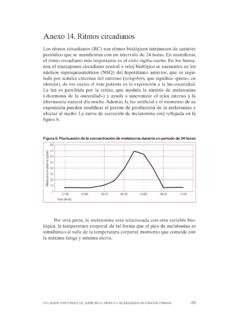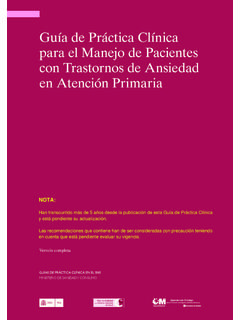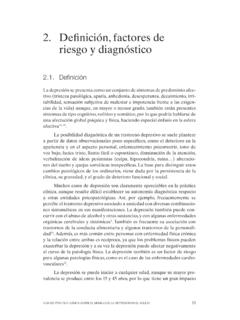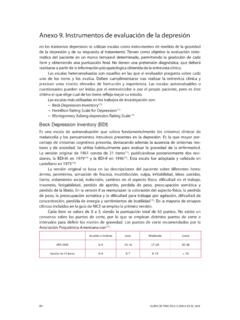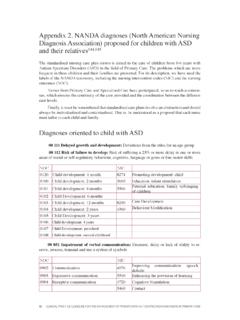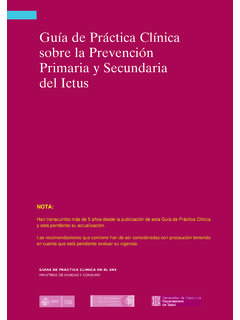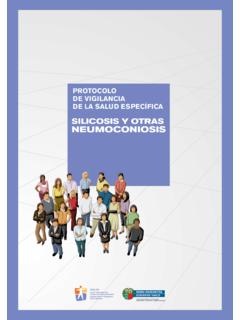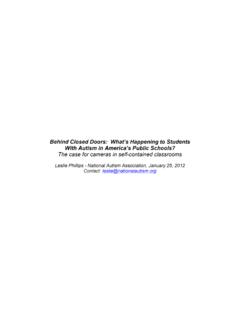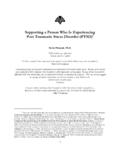Transcription of Appendix 7. Psychotherapeutic techniques - …
1 144 ClINICAl PrACTICe GuIDelINeS IN THe SNS Appendix 7. Psychotherapeutic techniquesPsychotherapy can be defined as the psychological treatment of emotional, behavioural, and per-sonality disorders, and it involves communication between a patient and a therapist and uses theoretically-based methods. All psychotherapies are based on the relationship between the thera-pist and the patient, as well as the use of procedures and specific can be offered in different formats (individual, family, group), and they can differ in specific dimensions such as the frequency of the sessions, the degree of the structuring, the duration, and the proposed , there are different forms of psychotherapy that are derived from particular expla-nations or theories of psychopathology.
2 Occasionally, this diversity is probably due to interests that are unrelated to scientific rigour or conceptual precision. In this regard, in 1993 Guattari pointed out that Psychotherapeutic practices and their theoretical formulations are currently in a state of almost total dispersion. This situation cannot be considered a sign of freedom, a stimulus to invention and to creativity, but rather it is the consequence of the sectarianism that reigns in this area and is the consequence of unawareness, which at times reaches irritating extremes, about everything that is happening inside each one of these restricted preserves.
3 261 Despite the dispersion in this field, the various Psychotherapeutic practices could be framed within five main groups: the behavioural approach, the cognitive approach, the psychodynamic approach, the humanistic approach, and the family approach. There are also other therapies that traditionally have not been included in these five groups but that have acquired great importance, such as interpersonal a starting point, before describing each one of the modes of psychotherapy, it should be pointed out that all of them, regardless of the theoretical model on which they are based, start with an assessment and a clinical formulation or conceptualisation of the problem or problems presented by the patient as a guide to the Psychotherapeutic strategy.
4 It must also be pointed out that all Psychotherapeutic approaches share general principles, such as the need to establish a therapeutic alliance with the patient or a cooperative relationship that heads towards the proposed objectives of Psychotherapeutic approaches on which controlled studies have been performed to as-sess their efficacy in childhood and adolescent depression and which have been reviewed in this guideline will be PSYCHOTHerAPYB ehavioural psychotherapy or behaviour therapy is an approach of clinical psychology that is based on the psychology of learning to explain psychological disorders and the
5 Development of strategies directed at therapeutic change. Another, central characteristic of this approach is that it is based on the experimental study of the principles and laws of learning, whose main processes are the following: Classical conditioning. It is based on the work of Pavlov and other Russian physiologists who performed experimental studies with dogs. They observed that when an initially neu-tral stimulus (for example, the sound of a bell) was paired with a stimulus, such as food, that was capable of causing unconditioned, automatic physiological responses, and after repeating the pairing a number of times, it began to cause a response (salivation) that was similar to what was caused by the unconditioned stimulus, even without the presence of the unconditioned stimulus.
6 The principle of classical conditioning, in addition to its ClINICAl PrACTICe GuIDelINe ON MAJOr DePreSSION IN CHIlDHOOD AND ADOleSCeNCe 145involvement in the acquisition of simple conditioned responses, can be involved in the acquisition of complex responses, such as those of anxiety and other emotional states in certain environmental conditions, which is highly relevant to explaining and psychologi-cally treating diverse emotional problems. Operant or instrumental conditioning refers to the learning of behavioural responses due to the environmental consequences or changes that they cause.
7 When behaviour is associ-ated with environmental changes or favourable consequences, this behaviour is positively reinforced and increases its likelihood of occurrence in the future. Conversely, negative consequences or no consequences would be associated with a decrease of the likelihood of occurrence of the behaviour in the future. In brief, a subject would learn to respond be-haviourally under particular environmental conditions (discriminative stimuli) due to the consequences of the subject s responses throughout their biographical history.
8 Observational or vicarious learning refers to the learning of behavioural patterns that are derived from the observation of others. In this case, the likelihood of the behaviour in-creases when it is observed that execution of the behaviour by others under certain stimu-lus conditions leads to favourable , the likelihood would decrease when it is observed that the behaviour in question is punished or is not followed by any relevance of language in human functioning is reflected in the development (from the behaviourist framework) of concepts such as derived relations or rule-governed behaviour , which are highly important to understanding a psychopathology and the treatment disorders are understood as the result of problematic learning experiences throughout one s biographical history.
9 Psychological symptoms would therefore be responses that have been learned through processes such as the is based on a behavioural assessment in which a functional analysis of the specific episodes of the problem is central to identifying both the antecedent conditions and the conse-quences of the problem behaviour. It is thus possible to establish a hypothesis about the main in-fluences that maintain the behaviour and, based on this, apply the pertinent therapeutic procedures based on the psychology of learning. However, contrary to a simplistic vision of behavioural therapy, it should be pointed out that, according to Marino P rez262, problems are presented and help is offered in the natural social context, which must be recognised as being complex with respect to the multitude of nuances that are continuously present.
10 This therefore means that the development of the behaviour can result in a list of scarce and inflexible forms with respect to the infinite nuances of the context. The issue according to behaviourist criteria is to stick to classes of behaviours that are defined precisely for generic purposes (not in the sense of being vague, but rather generalist) . In this same sense, it should be added that the context within which there is interaction must be understood in the broad sense, given that a person not only relates with exter-nal stimuli but also with private stimuli, such as verbal thoughts or images, emotions, and bodily sensations.
